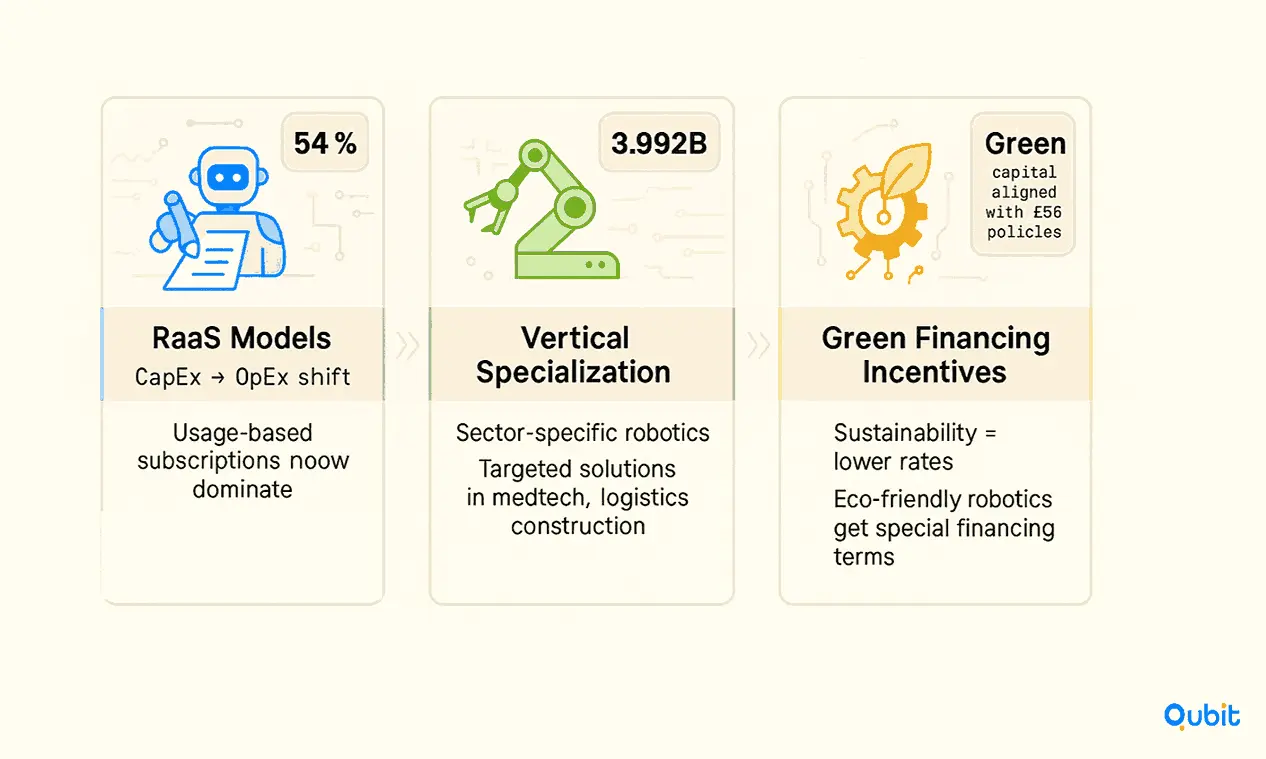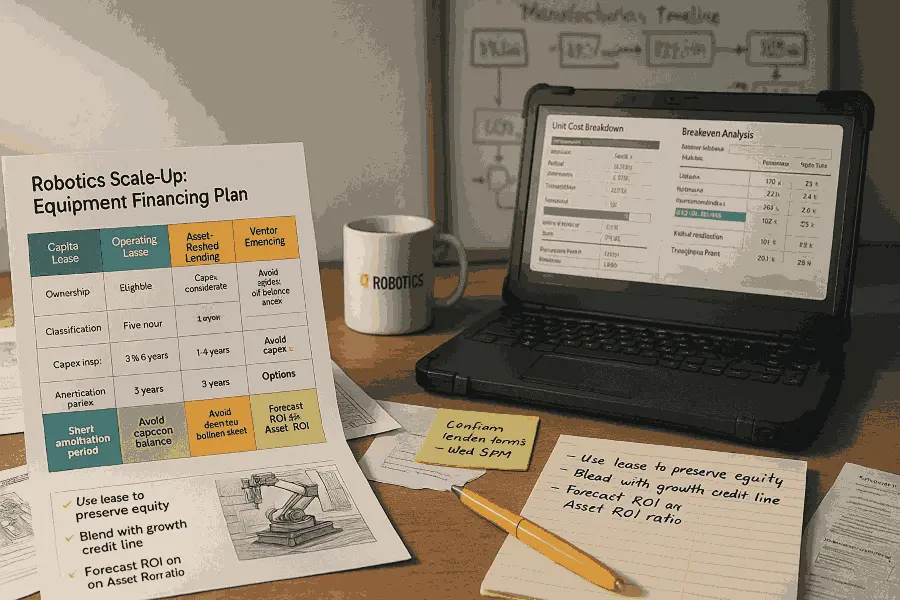Robotics scale-ups face unique challenges when expanding their operations, particularly when it comes to acquiring advanced equipment. Equipment financing offers a vital solution, enabling businesses to access cutting-edge technology without straining their capital. This approach is especially critical for robotics companies aiming to maintain momentum in a competitive market.
Understanding the nuances of financing options can help scale-ups make informed decisions that align with their growth strategies. For a broader perspective, connecting specialized robotics financing with broader industry trends can be insightful. For example, exploring fundraising strategies for deep-tech startups highlights how targeted financing insights intersect with broader deep-tech approaches.
This blog will delve into why equipment financing is pivotal for robotics scale-ups and provide actionable insights to help your business thrive. Let’s jump right in.
Core Strategies of Equipment Financing
Equipment financing represents a multifaceted approach to scaling robotics operations, encompassing various strategies that address the unique challenges and opportunities within the robotics industry. Understanding these core strategies enables companies to make informed decisions about their equipment acquisition and growth plans.
Benefits
Equipment financing transforms how robotics scale-ups approach capital-intensive growth. Rather than depleting cash reserves through large equipment purchases, companies can preserve liquidity while accessing state-of-the-art robotics technology that drives competitive advantages.
Cash Flow Preservation
Financing options allow companies to preserve cash flow while upgrading to cutting-edge robotics technology. This preservation enables simultaneous investment in research and development, talent acquisition, and market expansion activities that pure equipment purchases would otherwise preclude.
Accelerated Deployment
Access to financing supports the rapid deployment of machinery and accelerates operational growth. Companies can respond quickly to market opportunities without waiting to accumulate sufficient capital reserves, creating first-mover advantages in competitive markets.
Tax Advantages
Equipment financing often provides favorable tax treatment through depreciation benefits and potential deductions for lease payments. These advantages can significantly improve the total cost of ownership compared to outright purchases.
Technology Currency
Financing arrangements enable regular technology upgrades, ensuring robotics systems remain current with rapidly evolving industry standards. This technological currency prevents obsolescence and maintains competitive positioning in fast-moving markets.
A detailed review of key performance indicators highlights robotics startup Series A benchmarks, providing clarity on the metrics that shape early funding rounds. Companies that optimize their equipment financing can demonstrate stronger operational metrics when approaching Series A investors.
Challenges
Despite substantial benefits, equipment financing presents unique challenges for robotics scale-ups that must be carefully navigated to achieve optimal outcomes.
Interest Rate Sensitivity
High-interest rates and stringent credit checks can pose significant barriers for emerging robotics companies. Young companies often lack the credit history and collateral that traditional lenders require, leading to unfavorable terms or outright rejection.
Technology Obsolescence Risk
The rapid pace of technological change can render financing models outdated if not continuously reviewed. Long-term financing commitments may lock companies into equipment that becomes obsolete before the financing term expires.
Complex Approval Processes
Traditional equipment financing often involves lengthy approval processes that don't align with the agile decision-making requirements of scaling robotics companies. Multiple stakeholders, extensive documentation, and conservative underwriting approaches create delays.
Limited Industry Understanding
Many equipment finance providers lack deep understanding of robotics technology and market dynamics. This knowledge gap results in inappropriate financing structures that don't align with robotics business models and cash flow patterns.
Application Process
A streamlined application process is vital to ensure quick decision-making and adaptability in a competitive market. Successful robotics companies develop systematic approaches to equipment financing applications that minimize delays and maximize approval likelihood.
Documentation Preparation
Clear, well-documented procedures help companies navigate the complexities of financing and reduce administrative delays. Essential documentation includes financial statements, business plans, equipment specifications, and vendor quotations that demonstrate equipment necessity and expected returns.
Lender Selection Strategy
Targeting lenders with robotics industry experience significantly improves approval odds and terms. Specialized equipment finance companies often understand robotics cash flow patterns better than traditional banks, resulting in more appropriate financing structures.
Application Timeline Management
Coordinating application timing with equipment needs prevents operational disruptions. Leading companies begin financing applications 60-90 days before equipment delivery requirements, allowing sufficient time for approval and documentation completion.
Alternative Structure Consideration
An evaluation of collaborative approaches includes joint venture funding for deep-tech manufacturing, which outlines how partnership strategies can help manage capital expenditure. These alternatives often complement traditional equipment financing by reducing overall capital requirements.
Equipment Trends
Emerging trends indicate a significant shift towards advanced robotics, with financing models needing to adapt to rapid changes in equipment standards. Understanding these trends enables robotics scale-ups to structure financing arrangements that align with evolving market dynamics.

Robotics-as-a-Service (RaaS) Adoption
Subscription-based models are replacing upfront purchases, with payments aligned with usage metrics. This transformation reduces capital barriers for SMEs while shifting costs from CapEx to OpEx, fundamentally changing how equipment financing integrates with robotics deployment strategies.
Vertical Robotics Specialization
The industry shows a clear shift from generalized autonomous systems to industry-specific solutions targeting logistics, medical, and construction applications. This specialization attracts targeted investment and increases commercial viability, influencing how equipment financing aligns with specific sector requirements.
Green Financing Incentives
Specialized funding for eco-friendly robotics offers lower interest rates and government incentives. This emerging financing niche aligns sustainability goals with financing advantages, creating opportunities for robotics companies developing environmentally conscious solutions.
The global surgical robots market size was estimated at USD 3.92 billion in 2023, demonstrating the substantial market scale requiring financing support. Additionally, 54% of equipment acquisitions are forecast to be financed in 2024, highlighting the growing prevalence of financing in robotics adoption.
The discussion gains additional depth with an exploration of robotics materials startup funding, complementing the tailored financing strategies presented in this guide. This broader perspective helps companies understand how equipment financing fits within comprehensive funding strategies.
Case Studies
Case studies demonstrate successful applications of innovative financing strategies that have facilitated growth in robotics scale-ups. These examples serve as effective benchmarks for evaluating the potential risks and returns associated with equipment financing in high-tech industries.
Built Robotics Series C Financing
Built Robotics faced the challenge of scaling autonomous construction equipment across expanding markets. Their solution involved securing $64 million in Series C funding led by Tiger Global, with total funding exceeding $100 million. Results included successful expansion to Australia and demonstrated venture capital scaling for robotics startups requiring substantial equipment investments.
Chef Robotics RaaS Expansion
Chef Robotics addressed the challenge of funding AI-enabled food automation robots through an innovative approach. Their $43.1 million Series A combined equity and debt financing to support their Robotics-as-a-Service model. With total capital raised reaching approximately $65.6 million, they accelerated deployment of robotic systems while exemplifying hybrid financing approaches for robotics-as-a-service business models.
Geographic Investment Patterns
The US and China accounted for 75% of global robotics VC funding from 2018-2024, identifying key markets where equipment financing strategies prove most effective. This concentration provides insights into where robotics companies can access the most sophisticated financing options and industry expertise.
These case studies demonstrate how creative financing approaches enable robotics companies to scale operations efficiently while maintaining financial flexibility for continued growth and innovation.
Importance of Equipment Financing
Equipment financing represents a critical component of the broader robotics scaling ecosystem, enabling companies to bridge the gap between technological capabilities and capital requirements. The robotics industry's unique characteristics—high upfront costs, rapid technology evolution, and substantial growth potential—create specific financing needs that traditional approaches often inadequately address.
Modern equipment financing approaches recognize these industry dynamics by offering flexible terms, technology upgrade provisions, and payment structures aligned with robotics business models. Successful companies leverage these specialized financing options to maintain technological competitiveness while preserving equity for strategic investments and market expansion activities.
The convergence of favorable market conditions—including substantial venture investment, growing industry demand, and evolving financing models, creates an optimal environment for robotics scale-ups to access equipment financing. Companies that understand and capitalize on these conditions position themselves for accelerated growth and market leadership.
Strategic equipment financing enables robotics companies to achieve operational scale while maintaining the financial flexibility necessary for continued innovation and market expansion. This balance proves essential for long-term success in the dynamic robotics industry.
Key Considerations
Several critical factors determine equipment financing success for robotics scale-ups. Understanding these considerations enables companies to structure optimal financing arrangements that support both immediate equipment needs and long-term strategic objectives.
Financial Capacity Assessment
Companies must accurately assess their debt capacity and cash flow projections to determine appropriate financing amounts and terms. Overextending through equipment financing can constrain other growth activities, while underutilizing available financing may limit competitive positioning.
Equipment Lifecycle Management
Robotics technology evolves rapidly, requiring financing structures that accommodate regular upgrades and replacements. Companies should negotiate financing terms that include technology refresh provisions or flexible modification options.
Lender Relationship Development
Building relationships with specialized equipment finance providers creates access to better terms and more flexible arrangements. These relationships prove particularly valuable as companies scale and require increasingly sophisticated financing solutions.
Integration with Overall Funding Strategy
Equipment financing should complement rather than compete with equity financing and other funding sources. Companies must coordinate timing and terms across different funding streams to optimize overall capital structure and minimize conflicts between different investor or lender requirements.
Conclusion
Securing financing in the robotics industry requires a proactive approach and a clear understanding of available strategies. Throughout this blog, we’ve explored actionable insights to streamline financing efforts, from identifying the right funding sources to staying informed about emerging trends in the sector. These strategies are essential for overcoming challenges and ensuring sustainable growth.
A well-structured financing plan not only supports operational scalability but also positions businesses to adapt to evolving market demands. By implementing the discussed strategies, robotics companies can address their unique financial needs effectively.
If you're looking to secure the right financing for scaling your robotics operations, we at Qubit Capital can help with our Fundraising Assistance service. Contact us to get started today!
Key Takeaways
- Equipment financing is essential for alleviating capital constraints in robotics scale-ups.
- Flexible financing models, such as leasing and hybrid funding, are increasingly important.
- A streamlined application process improves decision-making and operational efficiency.
- Real-world case studies demonstrate the tangible benefits of innovative financing strategies.
- Ongoing advancements in robotics necessitate adaptive, forward-thinking financing solutions.
Frequently asked Questions
What is equipment financing for robotics startups?
Equipment financing for robotics startups allows businesses to access funds specifically for acquiring advanced machinery and technology. This type of funding helps startups scale their operations without requiring a significant upfront investment, making it easier to adopt cutting-edge tools.


 Back
Back



